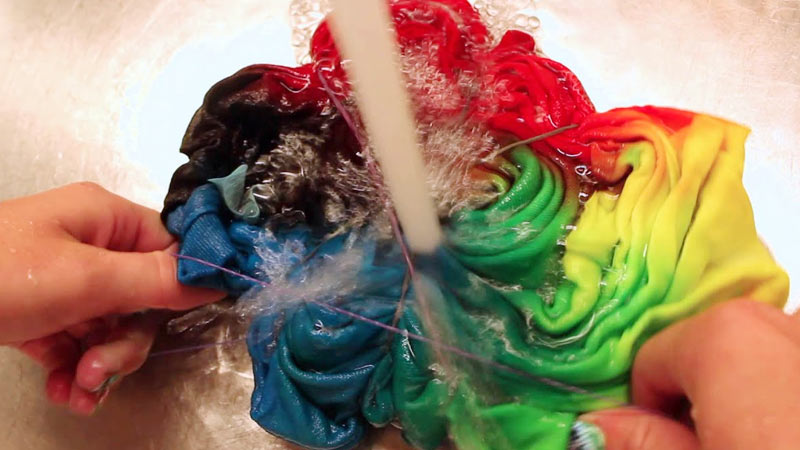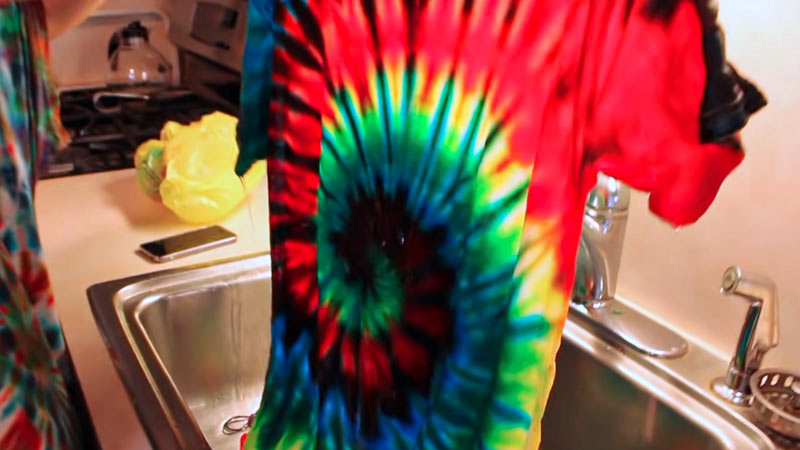Dyeing fabric is a fascinating art that brings life and vibrancy to textiles, transforming them into unique and colorful masterpieces. One intriguing aspect of this process is the potential of leaving the fabric in the dye overnight.
This practice, commonly employed with natural dyes or specific synthetic dyes, allows for deeper color penetration and more intense hues. However, its success hinges on various factors, including the type of dye used, the fabric material, and the desired outcome.
Whether you’re a seasoned dyer or a curious beginner, we are going to unravel the secrets behind achieving stunning, long-lasting colors on fabric.

Can You Leave Fabric in Dye Overnight?
Yes, you can leave the fabric in the dye overnight, and doing so can have various outcomes based on the following key points:
Dye Type
Natural dyes and certain synthetic dyes often benefit from an extended dyeing time. Natural dyes, derived from plants or minerals, tend to be milder and require more time to deeply penetrate the fabric fibers. Leaving the fabric in these dyes overnight can result in more vibrant and long-lasting colors.
Fabric Material
Different fabrics react differently to dyes. Natural fibers like cotton, silk, and wool tend to absorb dyes more readily, making them suitable for extended dyeing periods.
However, synthetic fibers, such as polyester, might not absorb dyes as effectively, leading to limited improvements in color intensity.
Desired Color Intensity
Leaving fabric in the dye overnight can lead to richer and more intense colors, but it might also risk over-dyeing. Achieving the desired color intensity requires finding the right balance between dye concentration, dyeing time, and fabric type.
Test Swatches
Before committing the entire fabric to an overnight dyeing process, it is essential to conduct test swatches. This allows you to monitor the color development at different time intervals, helping you determine the optimal dyeing time for your specific fabric and dye combination.
Manufacturer’s Instructions
Always follow the dye manufacturer’s instructions and guidelines for the best results. They may provide specific recommendations for dyeing times and concentrations, ensuring you achieve the desired color without compromising the fabric’s quality.
Advantages of Leaving Fabric in Dye Overnight

Leaving fabric in dye overnight offers several advantages, particularly when using certain types of dyes and fabric materials:
Deeper Color Penetration
Overnight dyeing allows the dye molecules to thoroughly penetrate the fabric fibers. This results in more vibrant and saturated colors, as the dye has more time to bond with the fabric, creating a long-lasting and rich hue.
Intensified Color Shades
Some dyes, especially natural dyes, require more time to develop their full-color potential. Leaving the fabric in the dye overnight enhances the color intensity, producing more striking and captivating shades.
Color Variation Control
Overnight dyeing allows for better control over color variations. By adjusting the dye concentration or dyeing time, you can achieve subtle variations in color intensity, creating unique and artistic effects on the fabric.
Enhanced Color Fastness
The extended dyeing time often contributes to improved color fastness. The dye molecules have a stronger bond with the fabric, making the colors more resistant to fading, washing, and exposure to light.
Suitable for Natural Dyes
Natural dyes, derived from plant sources, tend to be gentler and require more time to fully interact with the fabric. Overnight dyeing is particularly beneficial when working with natural dyes, resulting in more satisfying and consistent color outcomes.
Ideal for Absorbent Fabrics
Fabrics made from natural fibers like cotton, silk, and wool are more receptive to dye absorption. Leaving these fabrics in the dye overnight ensures even color distribution throughout the fabric.
Less Agitation Required
With longer dyeing times, there’s less need for continuous agitation during the dyeing process. This can be advantageous for delicate fabrics, reducing the risk of damage or distortion.
Cost and Time Efficiency
By dyeing multiple fabric pieces overnight, you can save time and resources compared to repeating the process for each individual piece separately.
Challenges to Leave Fabric in Dye Overnight
Leaving fabric in the dye overnight can present some challenges that need to be carefully considered:
Over-Dyeing
One of the main challenges is the risk of over-dyeing. Depending on the dye type and fabric material, leaving the fabric in the dye for too long can lead to excessively dark or uneven colors. This can be especially problematic with certain synthetic dyes, where prolonged exposure might not yield the desired results.
Color Inconsistency
Extended dyeing times can result in color inconsistencies, especially if the fabric is not evenly immersed in the dye bath. Uneven dye penetration can lead to mottled or patchy color distribution on the fabric.
Color Shifting
Some dyes may have a tendency to change color over time. Leaving fabric in these dyes overnight might result in a color shift, leading to unexpected or undesired color outcomes.
Fabric Damage
Prolonged exposure to the dye bath can weaken the fabric’s fibers, especially if the dye or the fabric type is harsh. This can lead to reduced fabric strength and durability.
Dye Waste
Leaving fabric in the dye overnight requires a larger volume of dye solution, leading to potential waste if not properly managed. This can be costly and environmentally unfriendly.
Time Management
Overnight dyeing can be time-consuming and may not be practical for all projects. For commercial or time-sensitive applications, a quicker dyeing process may be preferred.
Resource Management
Utilizing dyeing equipment and resources for extended periods can limit their availability for other dyeing projects or tasks.
Quality Control
Monitoring the dyeing process overnight requires careful planning and attention to detail. Without proper supervision, it can be challenging to control the final color outcome and ensure consistent results.
How Long Normally to keep Fabric in Dye
The duration for which fabric should be kept in the dye varies depending on several factors, including the type of dye, fabric material, desired color intensity, and the specific dyeing technique being used. In most cases, the dyeing time can range from a few minutes to several hours.
Here are some general guidelines for common dyeing methods:
Cold Water Dyeing
Cold water dyeing is often used with certain types of dyes, like fiber-reactive dyes. Fabric is soaked in the dye solution for about 30 minutes to an hour. This method is commonly used for tie-dyeing and other fabric art projects.
Hot Water Dyeing
Hot water dyeing is suitable for various dyes, including acid dyes for protein fibers like silk and wool. The fabric is simmered in the dye bath for around 30 minutes to an hour. Longer dyeing times may be required for achieving deeper colors.
Natural Dyeing
Dyeing with natural dyes typically involves simmering the fabric in the dye bath for an extended period, ranging from 1 hour to several hours. Some natural dyes may even benefit from overnight dyeing to achieve richer colors.
Direct Application Dyes
Fabric dyeing using direct application dyes, such as fabric paints or fabric markers, often involves allowing the dye to dry and then setting it with heat (ironing or baking) without the need for soaking the fabric.
Batik or Wax Resist Dyeing
Batik involves applying hot wax to the fabric to create patterns, and then dyeing the fabric. The dyeing time varies depending on the dye type and desired color saturation.
Dip Dyeing/Ombre Dyeing
For dip dyeing or achieving ombre effects, the fabric is dipped partially into the dye bath for short periods (a few seconds to a few minutes) and then gradually pulled out to create a gradient of colors.
FAQs
Can you leave any fabric in dye overnight?
Leaving fabric in dye overnight can be suitable for certain fabrics like cotton, silk, and wool, especially when using natural dyes or specific synthetic dyes. However, it may not be ideal for all fabric types, particularly synthetic fibers like polyester, which may not absorb dyes as effectively.
How does leaving fabric in dye overnight affect color intensity?
Leaving fabric in the dye overnight allows for deeper color penetration, resulting in more vibrant and intense colors. This is particularly beneficial when working with natural dyes or dyes that require more time to fully bond with the fabric fibers.
What are the risks of leaving fabric in dye overnight?
One potential risk is over-dyeing, which can lead to excessively dark or uneven colors. Color inconsistencies and color shifting might also occur if the fabric is not evenly immersed in the dye bath. Additionally, prolonged exposure to the dye bath may weaken the fabric fibers.
Can I achieve the same results with shorter dyeing times?
The dyeing time varies depending on the type of dye, fabric material, and desired color intensity. While leaving the fabric in dye overnight offers certain benefits, shorter dyeing times can also yield satisfactory results, especially with certain synthetic dyes or when using direct application dyes.
How can I ensure successful dyeing when leaving fabric in dye overnight?
Performing test swatches is crucial to determine the optimal dyeing time for your specific fabric and dye combination. Following the dye manufacturer’s guidelines and regularly monitoring the dyeing process can help maintain color consistency and achieve the desired results.
Conclusion
Leaving fabric in dye overnight can be a valuable technique in the dyeing process, offering the advantage of deeper color penetration and intensified color shades.
This practice is particularly effective with natural dyes and certain synthetic dyes, resulting in more vibrant and long-lasting colors.
However, it is essential to consider the fabric material, and type of dye, and conduct test swatches to avoid potential challenges like over-dyeing or color inconsistencies.
While overnight dyeing is beneficial for specific projects and fabric types, shorter dyeing times can also yield satisfactory results.
By understanding the nuances of leaving the fabric in the dye overnight, dyers can unlock the potential for creating stunning, unique textiles.
Leave a Reply